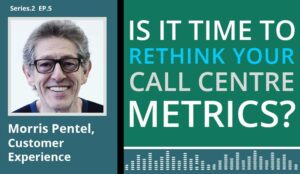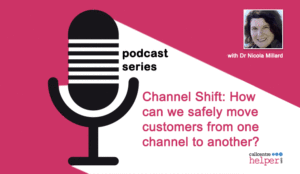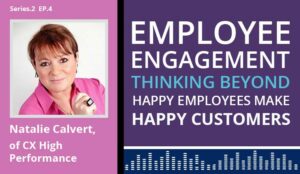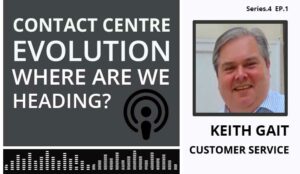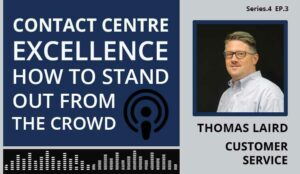The Contact Centre Podcast: Episode 11
In this episode, Morris Pentel of The Customer Experience Foundation shares his strong opinions regarding the future of contact centre metrics and discusses why we should consider moving away from certain traditional measures.

As part of our discussion, we also talk about the dangers of measuring success through metric scores alone, the growing focus on customer emotion and how best to measure the employee experience.
To listen to the podcast directly from this web page, just hit the play button below:
The Contact Centre Podcast – Episode 11:
Is It Time To Rethink Your Call Center Metrics?
This podcast was made possible by our sponsor, Genesys. We now have a new link to visit their website, instead of the link mentioned in the podcast to request a demo.
So, to find out more about Genesys, simply visit their website
Podcast Time Stamps
- 2:04 – Which Metrics Should We Be Using?
- 7:50 – Measuring Experience Efficiency
- 13:52 – Grasping Customer Emotion
- 20:19 – Understanding Customer Loyalty
- 26:13 – Advisor Experience
- 31:50 – What Goes Wrong In Customer Conversations
Here is a Transcript to the Podcast
Charlie Mitchell: So, there are key operational metrics that every contact centre needs to measure, but in terms of customer-facing metrics, like C-SAT, first contact resolution, or customer effort, how should we decide upon which metrics we should be using?
Morris Pentel: Very interesting question, and I think it is the heart of the customer experience debate in relation to contact centres at the moment. I think the short answer is that there are no single metrics that give you a clear understanding of what’s gone on in a conversation, in an experience, or in a relationship. When NPS, Net Promoter Score, started originally, the idea that a single question, it was called the ultimate question, would give you insight, was perfectly valid. But let me give an idea of some of the things that we now currently analyse across an organization, and then speak specifically, if I may, about contact centres. So, we’re interested in recommendation, we’re interested in satisfaction, we’re interested in efficiency, we’re interested in personalization, in emotion displayed, empathy, social engagement, digital behaviour, and a whole series of other pieces that are part of the conversation, or the experience of the customer and indeed of the employee. Does that give you an idea of just how broad a range of things there are that one could play with?
Charlie: Yeah, I think it’s interesting as well, you mentioned the idea of having a cross-organization strategy. And to my mind we often think too often in the contact centre that we have our own metrics, and other departments will have other metrics that they focus on. So, taking things from that angle, I think, was very interesting.
Morris: So, I guess if I focus on the contact centre for a second and we take the human part of the equation out, then a contact centre manager can manage the efficiency of their operation, excluding the human side of it. In terms of latency, in terms of the number of systems involved, in terms of the routing flexibility they’ve got. Their ability to run a successful contact centre operation is not a single metric. Although it ends up being a single metric in terms of being a good call routing platform together with a certain number of other elements, including good latency equals an efficient operation in which you can place people to answer calls. So, similarly, when you add the people to the conversation, then really the thing that you should be most concentrating on is the conversation itself. And it’s analysing the conversations of the contact centre where the largest failure is at the current time.
Charlie: So, do you think it’s dangerous for contact centres just to be measuring their success through metrics alone, as many still do?
Morris: Oh, absolutely. The difference between leaders and laggards is, and I’m very fortunate, I work in a world where I’m working primarily with leaders, but what they’re trying to do is they’re trying to understand emotion effect, they’re trying to understand empathy effect, they’re trying to understand what’s actually going on in the conversation. And let me give you one of my favourite examples of conversation analysis, because I’ve been involved in that world for a couple of years. I don’t profess to be an expert on the subject, but I understand it very well.
Morris: We can predict that a 0.7 of a second delay in an answer, under certain circumstances, will equal more than a 90% chance that someone is about to say “no”. We can also predict that, by using the phrase “Would you be willing?” rather than the phrase “Will you?”, you will increase the positive outcome by 50%. Now if you think about it, when you start to analyse conversations, suddenly what you’re able to do is understand everything, from the latency and the complexity of the systems the agents are working through, to the actual customer satisfaction at the end of the call. But at the moment, I think of contact centres primarily as organizations that know everything about a conversation, except for what’s being said.
Charlie: Well, this whole conversation is around how contact centres are using metrics at the moment. I always tend to think of Goodhart’s law, which applies to your point very well, which is when a measure becomes a target, it ceases to become a good measure.
Morris: Absolutely.
Charlie: And yeah, and we may be negatively impacting processes, even if we’re hitting our targets because we’re focusing on the wrong things.
Morris: Well, the bottom line for me is, I’m now looking as my main metric at experience efficiency. So, let me explain a little bit of that, if I may. Sometimes we want something in a hurry. Sometimes we want someone to spend time with us. Sometimes our needs are emotional, because perhaps we don’t trust something, or we don’t understand it. And the successful outcome of a call is that, “Actually, I’m no longer worried.” So, there are a huge number of human variables, but those human variables actually break down into a series of patterns. And so it is possible to understand these things, and it is possible to understand the conversation, but to go back to your point, when you have a target, you naturally move towards it. This is basic quantum physics; measurement affects the outcome.
Charlie: So, this experience efficiency that you’re talking about, is this something that you’re expecting more and more organizations to grow a focus on?
Morris: I see that at the moment. I see that the difference between the leaders and the laggards to me is, if I’m meeting a laggard, they will be telling me how they want to get around either their C-SAT or their NPS, in order to expand their understanding. If I’m talking to a leader, then what they’re talking about is, “How do we practically apply the understanding of empathy, or emotion, or other elements in the conversation, in order to move forward?” So, if people are thinking about single metrics, they are behind the curve of the very largest and the most advanced contact centres that I have experience of.
Charlie: It seems to me that a lot of these points that you’re talking about, with experience efficiency in terms of the human element, a lot of that can be measured through quality scores. Do you think that’s still the case? Or is that an old way of looking at it?
Morris: So, there are two elements to your question, and thank you for asking. The first is that, the way that we build our quality metrics at the moment, that we understand those quality metrics, is mathematically flawed. So, there are very few things in life that are a perfect 10, and any scoring system that goes from zero to 10 adds a level of confusion from the user’s point of view. And if you think that then gets translated by somebody else, who wasn’t necessarily privy to it, in order to produce a result, then what you have is, in our terms, the equivalent of Chinese Whispers. The understanding of what people say gives you a much clearer set of insights that are actionable. So, if you can hear somebody say, “This is the second time that I’ve called,” then you know that somewhere at the root of this, and something that needs root cause analysis, is going to be First Call Resolution.
Morris: In fact, let me give you a great example. One of the pieces of work that I did a couple of years ago was for a very large contact centre organization. I’m a great believer in delivering small habits and changes to contact centre staff, because if you’ve got more than a thousand people, you’re not going to take them off the phone for the day. You’ve got to create new habits. And so, the first new habit that we created within this contact centre was to say, “Actually, does the customer sound angry or not at the outset?” And in which case, if the customer sounds angry, spend time calming the customer down. Now, that would seem counterintuitive from the point of Average Handling Time, but in fact it reduces average handling time, because less angry customers tend to go off on less tangents, taking up less time of agents, and ending up in more satisfactory conclusions.
Charlie: This is a very interesting topic as well. Not only from the perspective of those high up in the organization, but in terms of a changing advisor role as well. Maybe in the fact that they’ll need to be more aware of how their behaviours impact the customer. Do you see increased coaching needing to be on the agenda very soon?
Morris: Very much so. And different kinds of coaching. If you were to look in the job ads within the call centre industry, you would find some pieces notably missing. Number one is behavioural analysis. Actually understanding the customer, actually understanding the human condition. And let me give you a really simple example, and I know it’s one that I speak about a lot, but if you play music at 120 beats a minute to somebody sitting in an IVR queue, their heart will race. And that’s not exactly how you want to deliver them to an agent who they’re about to complain to.
So, understanding people more is one of those taboo areas that we have had for years. People, even some of the great customer experience gurus of my generation, and the generation after me, talk about emotion as though it’s difficult to understand. And to some extent that’s true. But the effects of emotions, and by effect, what I mean is what outcome emotions produce, has been an understandable science for nearly a hundred years. It’s the basis of medical diagnosis. So, what we’re needing to do is to widen our gaze in the call centre, to look at things like behavioural analysis, to look at conversation, to look at other pieces, and then deliver that into the contact centre as training for staff. But this is also against a background where a huge number of tasks are still being moved out of the contact centre. So, our people are generally dealing with more complex problems, rather than things that we can hand off to automation, like bots and other pieces.
Charlie: Yeah, I think the fact that we have rising self-service, well, better self-service, and an increasing number of organizations using chatbots to automate calls, is really going to have a big influence on advisors, and maybe we will need to react to that by perhaps lowering occupancy. So, advisors get longer breaks between calls, because handling time will probably increase as well. So, there’s lots of varying things that we’ll need to consider in the future.
Morris: Absolutely. I didn’t mean to cut across, but even mindfulness, i.e. the ability to reset yourself after a long call, will be part of one of those new elements of training.
Charlie: Yeah. And I think one other point that you mentioned as you were speaking earlier, was this increasing focus on emotion, and I saw some research a few weeks ago, of how emotion has a bigger influence over loyalty than the success of a customer in getting their query answered, and the effort it takes them to do so.
Morris: Yes.
Charlie: But I’m not really seeing many widely used measures of emotion. I’m seeing maybe a little bit of sentiment analysis through analytics systems, but how else would you suggest contact centres start measuring emotion?
Morris: Well, here I’m going to have to get partisan. Over the past three years, the Customer Experience Foundation has invested hugely in the understanding of emotion from the organizational point of view. And what we learnt through that research and work is that there are basically nine emotional states that impact outcome. So, although there may be many words to describe emotion, whether or not I’m dissatisfied, or disillusioned, or disaffected is a more complicated problem. But whether something is a little bad, a lot bad, very bad, or completely bad, is something different. So we divide emotions into two basic types, emotions that are passive, which means I may not like you very much, but I’m not going to leave you as a customer, and emotions that are active, which means I’m either going to spend more money with you or I’m trying to leave you, or I am bad mouthing you socially.
So, doctors think about emotions in terms of “How did you feel before? Once you’d had the treatment, how did you feel?” And it’s that simple. “Did you feel that the outcome made you feel better or worse?” That’s not rocket science. That’s what we do. A friend of mine, Professor Elizabeth Stokoe from Loughborough University, in her wonderful book, Talk, starts out with the proposition that conversation is what actually separates Homo sapiens from the previous states. Conversation is designed by us to be understood by everyone. And similarly, as you wander about in your life, you can see who is distressed, you can see who is happy. This is not rocket science. It’s only business has been very reluctant, because of our historical focus on business being business, to expand its thinking.
Morris: So, I believe that there are simple metrics that can be used. There are certainly, on the Customer Experience Foundation, free insights on the subject. I think most people are still trying to over-complicate it, rather than think about it in the most simple terms. And if I could give one piece of advice to any contact centre manager, it would be, try to think of it as the emotions of a child. Keep it that simple. They’re either happy, they’re unhappy, they’re either engaged, they’re not engaged, they’re either throwing a tantrum or they’re not throwing a tantrum. Now, yeah, it’s a little more complicated than that. But when you start to explain things simply, so colleagues can understand, you unlock emotions, you unlock conversations. So, I think there’s a lot of people talking about really complicated things that are to do with emotions, but they’re not getting to the bottom line of how simple they are to us, as human beings, to understand.
Charlie: And it makes me think of an article that I’ve read recently, which says customer loyalty is dead, which I really disagreed with just from the point that, I’m still loyal to certain companies, but these companies are organizations that I’ve had positive experiences in the past, and I’ve built up positive memories, and that in turn links to an emotion. So, it’s as simple as that, isn’t it? In terms of building these positive memories in people’s minds and they’ll come back to you.
Morris: It’s not quite as simple as that. But that is simply true. And what I mean by that – and I know I’m being a consultant by saying both – what I mean by that is that there are other factors that cause you to be loyal to an organization, beyond simple memory. So, for instance, although Amazon’s impact on the world globally, in terms of retail, is relatively small, I think it’s still under 5%, they are in 50% of American homes. And they are more trusted as an organization than anybody in America bar the military. Now, if you look at Facebook in terms of trust and loyalty, according to the same research, they sit at the bottom of the pile, in terms of trust, along with the American Congress and estate agents.
Morris: So, it is a question of both “I remember good experiences, but I feel that I can trust you”. And this whole question of customer trust is one of the biggest issues that I think… First of all, trust is an emotion. So, we are talking about the same thing, but it also has a huge impact on customer loyalty. And if I don’t trust you with my information, if I don’t trust you to be doing the right thing, if I don’t trust you to be concerned with the welfare of your workers, concerned with the welfare of our planet, those emotions might well cause me to think about another supplier, even though you may have treated me well. In other words, although I like my iPhone, if I found that they really were using children in China to make them, I’d get rid of all of my Apple products tomorrow, even though I am hugely addicted to them.
So, there is a social compact at the heart of emotion that we all have but is frequently not expressed. So, yes, good memories are a feature of it. Delivering good experiences every time is a feature of it. But there are other emotional features to loyalty.
Charlie: But the fact that a lot of them are not expressed, that must be quite difficult for us to measure, surely? Because if customers themselves aren’t sure what drives their positive emotion, is that going to be a problem in terms of measurement?
Morris: Well, I think as long as we are in the world of survey measurement, and to be clear, surveys, everyone has heard the term “survey fatigue”. Let me give you a few other terms to demonstrate where we’ve got to: “junk mail”, “spamming”. We’ve taken something like surveys, and we’ve turned them into bad practice, and as a result, we may be asking the satisfaction question, but we’re asking it against a background where too many organizations have asked the same thing. Listen to a conversation and you can hear so much more.
So, the idea of a post-event survey, which from the point of view of a psychologist or a psychiatrist would not necessarily be as valid as actually listening to what happens, i.e. observation of facts, those surveys have significantly less value. So, when we talk about measuring satisfaction, we’ve got to get away from this addiction to post-event surveys and start delving into the conversations.
I spoke to one of the world’s largest companies last week, who I’m doing some stuff with, and what we were talking about is how to use what’s going on in the conversation to understand how well we’re doing, and to change the outcome if it’s not doing well.
That’s where this divide between current customer experience practice and the future of customer experience practice in the contact centre is going to happen. It’s actually getting into the meat of what’s really happening, rather than allowing a separate silo, or as we call it, the insight department, go off and do something that most people don’t like to answer. So I spent a huge amount of money giving you a fantastic experience, and then I give you a really bad experience that says to you, “Actually, you’re just a survey to me,” and that doesn’t make business sense.
Charlie: It’s quite interesting that you say this with surveys as well, because one other point that I wanted to touch on was measuring not only the experience of the customers, but the experience of our advisors.
Morris: Yes.
Charlie: Do you think that there’s other ways that we can do this, apart from maybe the traditional annual survey, which won’t tell us very much at all?
Morris: I’m going to go back to the one thing where we can analyse exactly what’s going on, which is the conversation. So, when we listen to conversations between agents and customers, what we’re able to hear is, we’re able to hear the tiredness, frustration, happiness, empathy of the staff. We’re also able to hear how complex the systems are, how much thinking is going in, how much employee effort is going into understanding what the customer is saying. So, a conversation will not only talk about the problem, but will give you insights into how your employees are doing. In a recent case that I worked on, I heard an employee give the same answer to 40 different people in a single day. And the result of that answer was the question “What?” or “What do you mean?” Now if you’re analysing conversations, it’s not rocket science to say that, if someone’s asking that question, “What do you mean?”, quite clearly our explanation is not right.
But just to be absolutely clear, because there is an alternative, the question, not what, may prove to be the next step in a process. So, really understanding what’s actually happening in the conversations. Firstly, it’s massively more available. We have the conversations going on in our contact centres. We need to just rethink the way we understand what’s going on in the contact centre in order to produce the best outcomes for our employees and for our customers, because happy employees and staff tend to produce better financial results.
Charlie: It’s interesting, your responses to each of my questions, you’re just trying to not use traditional metrics but find other ways of creating more actionable insights.
Morris: There’s a reason for that, and the reason is, though I have spent most of the last 10 years avoiding saying this, I will say this now, clearly, surveys are a bad waste of money now. It doesn’t mean that getting voice, the customer insight, is a bad thing, but in general, if you look at the majority of surveys and you look at the response rates, you look at the quantity of insight that they produce. I currently feel they represent bad practice. And I can give you a fantastic example of how what once was great practice, and regarded as a huge innovation, has become terrible practice. So, when Fred Reichheld originally came up with “would you recommend us?” it was a great step forward. It brought customer experience into the boardroom for first time.
Recently, being ill, I was lying in an A&E, and I received a text from the National Health Service, asking me how likely I was to recommend the A&E. Now, you think about that as a question. First of all, if you’re in distress, seek medical advice, don’t ask your friends and family. Secondly, how would that question go? “Oh, you’re having a heart attack. I think that hospital A is better than hospital B.” Two things. The first one is, if someone has been in A&E, what is the probability that 12 to 24 hours later they are still in medical treatment? It’s high. And fourthly, if this is the only contact you’re about to have with a customer, or in this case a patient, is that the right thing to say?
And it’s that, to me, as I said earlier, there are two types of customer experience people. There are the practitioners and there are the scientists. I’m a scientist. To me, customer experience is a matter of physics. It’s a way of understanding the world that obeys a set of laws of physics that most people aren’t familiar with, but it is a science. And what I see is the effort involved in surveys is the equivalent of trying to row a boat backwards when the back of the boat has a flat side designed to hold an engine, and you are actually pushing against the bow.
You’re creating much more effort for the customer in the wrong circumstance, and in contact centres we have highly available information that gives us insights about everything, from the emotional states of our customers through to the emotional states of our staff, through to – I’ll just give you a couple more pieces, I know I go on about this – I’ll just give you a couple more pieces, extra-long sentences. When no one replies, increased aggression, a whole series. There are 14 patterns of things that go wrong in conversations. And my favourite one is “Is there anything else I can help you with?” when you haven’t helped me. So, can you measure the negative impact of that? Yes, of course you can, but you need broader business cases, and you need better business cases. And that’s one of the areas where, not just contact centres but organizations in general, are struggling to get up to date with the latest thinking.
Charlie: Agreed. And I just want to lastly focus on customer emotion again, which has been a key motive of this podcast, and talk a little bit about the peak-end rule. This says that we should be designing experiences to have a peaking customer emotion somewhere in the middle and at the end of the conversation. So, should we be measuring where our emotional peaks are within the customer journey?
Morris: What I would say is that organizations need to be able to identify emotional peaks, and to react to them, not to use them as part of a survey formula. I am so opposed to surveys that I think getting voice of the customer post-event is an absolutely valid thing. But most of the surveys that I read put words in the customer’s mouth, and one slice, of one moment, on one day post-event, and that doesn’t tell you enough. Retail is in a challenging space at the moment. So are financial services, so is everybody.
The contact centre industry supports an entire world, where in recent years we’ve heard results that, although we’re spending more money on customer experience, people are getting less and less happy with it. And the reason for that in part, in my view, and it is only a view in this case, because I don’t have the science for it, is I think we fixed a lot of the small stuff. But what people are now looking for is real change. So the idea that I have to walk into a mobile phone shop and spend 40 minutes going through a process, when they have all the data about me on my phone, and I should be able to walk in and walk out, is something I’ve been working on with a number of very large mobile retailers around the world over this last year. Because they’ve still not replaced processes with experience. And what I mean by that is, first build the experience and then add the processes to it.
Charlie: I agree. And I also think another reason for why people may perceive customer experiences to be getting worse, is because Amazon have set the bar so high, in terms of things like low customer effort, and I think that’s a great point to end on there, Morris, but before we go, is there anywhere where our listeners can find out more about what you do at the Customer Experience Foundation?
Morris: So yes, they can visit CXFO.org. They do not have to sign up. They do not have to become members. We do publish an awful lot of free information, and we do do free advisories, for 30 minutes, before anybody gets too excited. But there we try and publish honest insights that we’ve seen out there in the world. The Foundation’s mission was always that, and I’m proud to say that 10, 11 years on, we’re still just publishing things that we find interesting, and useful, and applicable, for contact centres and other parts of business.
Author: Robyn Coppell
Reviewed by: Jo Robinson
Published On: 11th Nov 2019 - Last modified: 10th May 2024
Read more about - Podcasts, Charlie Mitchell, Genesys, Metrics, Morris Pentel





